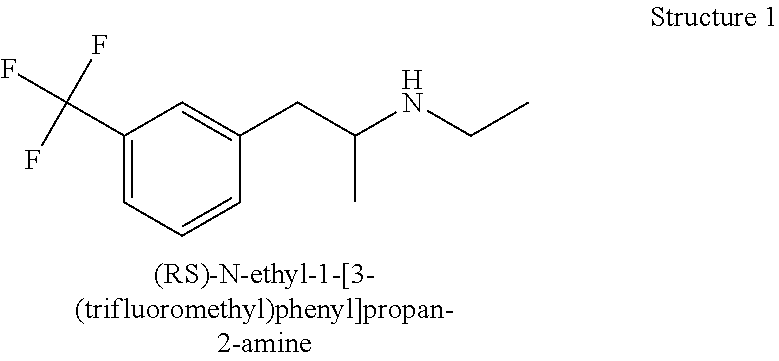Ketogenic diet compatible fenfluramine formulation
a fenfluramine and ketogenic diet technology, applied in the field of ketogenic diet compatible fenfluramine formulation, can solve the problems of withdrawn from the us market, poor development of language and motor skills, and children with dravet syndrome are likely to experience multiple seizures per day, so as to increase the compliance of a ketogenic diet and reduce the patient's craving for carbohydrates.
- Summary
- Abstract
- Description
- Claims
- Application Information
AI Technical Summary
Benefits of technology
Problems solved by technology
Method used
Image
Examples
example 1
Components of the Drug Product [Fenfluramine, Oral Solution]
[0105]Drug Substance
[0106]Compatibility of the Drug Substance with the Excipients
[0107]The compatibility of fenfluramine hydrochloride in solution with the formulation excipients has been established through development stability studies. Multiple formulations including various combinations of the ingredients were evaluated at long-term and accelerated storage conditions. In addition, results to date from ICH-compliant stability studies of the intended commercial formulation provide further evidence of the compatibility of the drug substance with the formulation excipients.
[0108]Physicochemical Characteristics of the Drug Substance
[0109]The physicochemical properties of fenfluramine hydrochloride drug substance are summarized below. Properties that are relevant to the performance and manufacturability of the drug product are discussed below.
[0110]Solid State
[0111]Fenfluramine hydrochloride is a crystalline material that exi...
example 2
[0154]Formulation Development [Fenfluramine, Oral Solution]
[0155]Overview
[0156]Earlier open label clinical studies in Dravet syndrome (DS) were conducted using a solid oral dosage form (capsules containing a blend of API and lactose) for dispersion in a liquid vehicle prior to administration. The subsequent development activities aimed at producing a liquid formulation for oral administration, with a single concentration of fenfluramine hydrochloride that is suitable for pediatric or adult use across the entire dosing range, and is stored in a multi-use bottle at room temperature. Other target product properties and their justification are briefly discussed below.
[0157]Aqueous Solution:
[0158]An aqueous oral solution is generally considered an acceptable dosage form for children as young as newborns. The liquid dosage form provides flexibility for age-based or weight-based dosing. The target range of dose volumes (0.5 mL to 6 mL) is small enough for administering to young children wi...
example 3
[0211]Description of the Dosage Form
[0212]Fenfluramine solution for oral administration is a colorless, cherry-flavored oral solution containing 2.5 mg / mL fenfluramine hydrochloride (equivalent to 2.16 mg / mL fenfluramine) in aqueous vehicle.
[0213]The solution is contained in a multi-dose high density polyethylene (HDPE) bottle capped with child resistant, tamper-evident closures. The product will be administered using a suitable size oral syringe that will be dispensed with the drug product. A press-in bottle adapter will be inserted in the bottle opening prior to dispensing.
[0214]Composition
[0215]The composition of fenfluramine oral solution is listed in Table 8.
TABLE 8Composition of Fenfluramine Oral SolutionAmountIngredientFunction(mg / mL)Fenfluramine HClActive2.5Methylparaben SodiumPreservative2.0bEthylparaben SodiumPreservative0.2bSucraloseSweetener1.0HydroxyethylcelluloseThickener5.0Cherry Flavoring PowderFlavoring agent1.0Potassium citrate monohydrateBuffering agent10.2Citric ...
PUM
| Property | Measurement | Unit |
|---|---|---|
| concentration | aaaaa | aaaaa |
| concentration | aaaaa | aaaaa |
| concentration | aaaaa | aaaaa |
Abstract
Description
Claims
Application Information
 Login to View More
Login to View More - R&D
- Intellectual Property
- Life Sciences
- Materials
- Tech Scout
- Unparalleled Data Quality
- Higher Quality Content
- 60% Fewer Hallucinations
Browse by: Latest US Patents, China's latest patents, Technical Efficacy Thesaurus, Application Domain, Technology Topic, Popular Technical Reports.
© 2025 PatSnap. All rights reserved.Legal|Privacy policy|Modern Slavery Act Transparency Statement|Sitemap|About US| Contact US: help@patsnap.com

